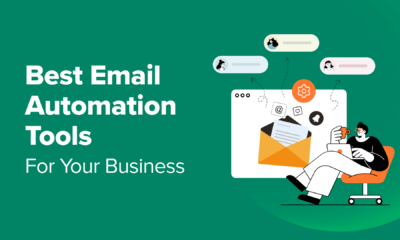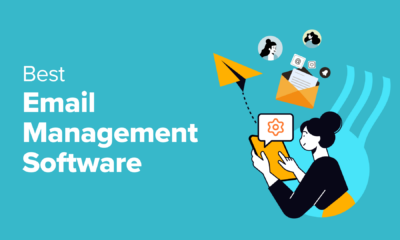MARKETING
Exploring Advanced Email Personalization Techniques

Statistics show that email marketing is a powerful tool for building long-term relationships with your customers. However, email marketing works only if its content is personalized.
If done properly, customized emails can enhance customer experience by 58%.
Furthermore, a smart email marketing campaign can boost click-through rates by 75% and open rates by 82%. Businesses report that personalized email marketing improves a series of other performance indicators as well. Some of them are listed in the chart below.
Therefore, email marketing is a necessary element of effective business promotion. Although some marketers think that it is an old-fashioned way of marketing, it is far from outdated.
On the contrary, a successful email marketing campaign requires the latest technology and software. Apart from that, it requires knowledge and careful planning to make it work.
But before we get to email marketing tactics, it is important to understand the value of personalization.
What Is email personalization and why is it important?
People are exposed to a lot of ads these days. As a result, it is getting harder to attract their attention.
No one wants to read generic emails anymore. Therefore, customization and personalization of content are considered the future of email marketing.
In order to prove that you care about your customers, you want to deliver only useful and interesting content to their inboxes.
Compared to generic emails, customized and personalized emails have a 26% more chance of opening. Furthermore, they make over 7 times more income and 6 times higher transaction rates.
One of the most common forms of email marketing is sending newsletters. The purpose of newsletters is to inform, engage, and drive customers towards products and services. Almost 80% of marketers agree that creating a newsletter is an effective way to make new leads
The benefits of email marketing personalization are many. Here is a list of the most important ones:
- it drives conversions
- reduces unsubscribe rates
- provides valuable information about customers and their feedback
- it is very cost-effective
Email marketing is very impactful in itself, but it gives the best results if combined with other types of marketing. Experts say that the combination of SMS and email marketing is particularly mighty. This is because it gives you the opportunity to simultaneously target your audience through their mobile and desktop devices.
Who are you addressing?
If you want your emails to be this effective, you will have to know who you are addressing. In-depth learning about your customers is crucial, and not as easy as it might seem.
The process of learning about your customers is the first step in market segmentation. According to a survey, gathering this information is a major source of challenges for marketers. In order to understand leads, it is necessary to know the following:
- the basic demographics (age, gender, location, average earnings, etc.)
- buying habits (based on previous purchases and activity)
- the engagement (some users are more likely to dedicate time to emails than others)
- preferred devices your target audience uses to read emails (mobile phones, desktop, tablets, etc.)
The big question is: where to find the data?
How to find data?
There are several ways to get useful information about your customers.
The easiest and most reliable way to get the data is to ask. Once a new subscriber is on board, you can ask them to answer a short survey or a signup form. The form would allow the user to specify details such as birthday, interests, location, job title, etc.
Remember to keep it short and friendly, and avoid too personal questions.
If that doesn’t work, or you would like to know more, you could use a marketing automation tool. There are many available automation tools in the market that can help you know your customers much faster and better.
Most of these tools are drag-and-drop and easy to use. However, others require basics in coding, so you might need some time to learn how to get the best out of them.
Finally, hiring a professional marketing agency is also an option. Although it is a bit costly solution, marketing agencies have a series of advantages. First of all, they have access to SEO tools that provide them with insights unavailable to common Internet users.
Additionally, their teams consist of top-notch professionals, whose job is to provide you with solutions based on thorough analysis and big data.

Outline one or more buyer personas
The benefits of analyzing your customer’s purchasing behavior are multifold. The most important goal of such an analysis is a deep understanding of your target audience.
A buyer persona refers to ideal models of your customers. It doesn’t represent any particular person, but rather a type of people who are likely to buy your products.
Usually, having buyer personas will help you create your content accordingly. A common example of a buyer persona is Working Mom Wendy. So, if working mothers are your target audience, then you know that they are:
- middleaged women
- probably running home economy
- interested in cooking, healthcare, and wellness
- probably quite busy
Therefore, according to this profile, you will know how to best adjust your content. In this case, for instance, you should emphasize wellness topics, discounts, and present shorter content forms.
Recommend similar products
One of the most common ways email marketing works is through personalized recommendations. Emails are a great tool for upselling, especially for businesses that offer a great variety of products.
So, if a person buys a raincoat, you can guess that they might need an umbrella as well. Or, you noticed that a person is interested in skincare products. In that case, you could recommend a sun cream that is currently on sale.
Of course, it is impossible to track each customer manually. There are various software solutions designed to track customer behavior and send customized email recommendations.
Dynamic content is the new trend
Dynamic content is a fully automated personalized email marketing.
Email builder tools are able to adjust the email templates in real-time, according to available data. There is no need to manually create different email types for each buyer persona. You can send the same email, and let the software automatically adjust images, content, and message.
Offer classes and tutorials
Sending classes or tutorials on the topic of their interest provides people with real value. If they get to learn something interesting thanks to you, they will eagerly expect to hear from you again.
For example, let’s say you are a hypnotherapist. You could make a short introduction to hypnosis, break it into four educational videos, and send a new video each week. Thus, if you manage to spark their interest, people will book a session.
Besides, this approach shows that you aren’t sending the email only to get something out of it. The prospects appreciate businesses that are willing to give before they ask for something in return.
Pay special attention to the subject line
Email subject lines are the first words a prospect will read. Therefore, it is impossible to overemphasize their importance.
Just like the rest of the email, it is a good idea to personalize subject lines as well. Custom subject lines can increase the percentage of open emails. Moreover, they positively influence email revenue.
Take into consideration the client’s current stage at the funnel
The marketing funnel is a model that represents different phases of a customer journey. As you can imagine, customers at different stages require emails relevant to their current status.
Managing to adjust emails to customers at each of the stages is the true art of email marketing.
In practice, it means emails are able to move the prospect through the stages, from warming them up at the cold email stage all the way through to the purchase stage. They are powerful tools you can use if a customer gets stuck.
For example, once someone signs up, it is a good idea to send them a welcome email. In this email, you could tell them a bit more about yourself. Hopefully, it will spark interest and move them to the next stage.
Also, if a person abandons the purchase on the shipping details page, it probably means they don’t like delivery conditions or price. In such a case, a friendly email with a shipping discount could make a true difference. Except for making the purchase happen, it sends a message that you truly care about your customers.

Take care of the annoyance level
The balance between being persistent and polite is crucial in email marketing. You don’t want to push it too far, as this can have the opposite effects. Annoying your prospects will only make them walk away for good.
That’s why you want to choose an email system with a dashboard to let you get an overview of your campaign – ideally one that lets you use rapid templates to target your market segments and carefully schedule emails in advance. You don’t want to send more than a couple of emails a week. If a person receives too many emails from you, their engagement will probably drop.
Even worse, the mailing service might recognize your emails as spam. Therefore, in order to avoid the spam folder, make sure to comply with CAN-SPAM Act.
Use automation
It is clear from everything above that email marketing campaigns require a healthy dose of automation. It is impossible to hand over the entire process to the machines. Human touch is necessary, especially for content creation.
However, the software is very helpful with repetitive tasks and data collection.
Usually, automation tools ask you to set triggers and define the appropriate actions. Here are some email automation tips for taking full advantage of email marketing software:
- make creative and engaging subscription pop-ups. They will remind visitors of your website of all the benefits of your newsletter.
- collect feedback from customers
- send reminder emails to prevent cart abandonment and the subscription expiry.

Final thoughts
An exceptional customer experience is an important means of staying ahead of your competition. Companies that dedicate time and effort to provide valuable content to their customers are rare.
Email marketing is a powerful, effective, and cost-effective way to build your brand. It allows you to show your customers that you care about their opinion. In turn, you can expect to gain their trust and long-term loyalty.
Finally, combined with social media and SMS marketing, personalized emails can make staggering results.
Source link



















You must be logged in to post a comment Login